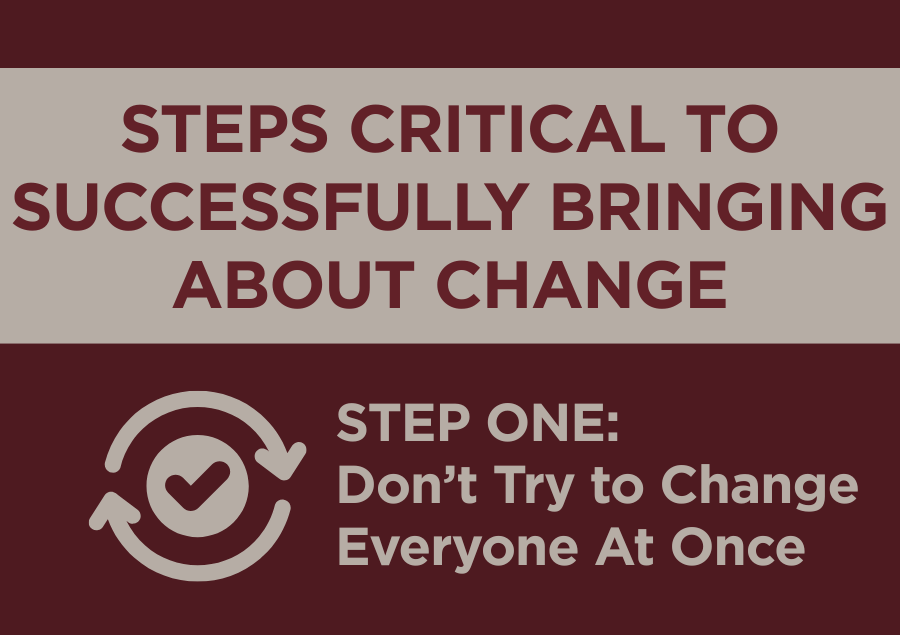
Tim O’Neill, Executive Director
Steps Critical To Successfully Bringing About Change
There is no doubt that if we want to see more churches planted in Australia, we need to see more workers who will go into the harvest raised. And this requires changes to be made. Why do I say that? Simply because if no changes need to be made, we would have all the workers we need to be deployed into the harvest to reach people, make disciples and plant more churches.
One of the biggest dilemmas that many church leaders face is how to practically bring about change that works. Successfully bringing about change provides a doorway we can journey through to the future. Not doing so means that the practices of the past will stay with us.
You have probably heard of the story of the frog in the saucepan. When the water was cool, all was good for the frog. But as the temperature slowly increased, the frog stayed there until eventually the frog was dead, killed by the boiling water.
It’s clear that unless we want to be like the frog, many churches around Australia need to move to bring about change. Many leaders know that they must bring about change if their church is not only to survive into the future but to see multiplication occurring through disciples making disciples, leaders raising leaders and churches planting churches. But how to do it without splitting or damaging the church is a dilemma for many.
Following are 5 Key Principles that I hope are useful in bringing about change effectively.
ONE: Don’t Try To Change Everyone At Once
TWO: Look For Those Who Are Open To The New
THREE: Find The People Who Haven’t Yet Become Set In Their Ways
FOUR: Look For The Tweaks You Can Make Over Time
FIVE: Start Something New
We will unpack each of these 5 Key Principles over the next 5 weeks. Here’s the first of the Principles:
ONE: Don’t Try To Change Everyone At Once
Most people don’t mind change. That is unless it affects them. But some people are open to change. In fact some even look for the new, willing to discard the old.
One of the biggest mistakes that we can make when we seek to bring about change is to change everything at once. Imagine the senior pastor standing in front of the congregation and saying “we used to do it this way, but now we are going to do it a new way”. The leader would likely have some who were excited, some who silently thought “we’ll wait and see” and some who were resistant.
Bringing about change is one of the key tasks of leadership. It’s also something that requires skill.
I’ve heard it said that effective change management is illustrated by throwing a pebble into a pond, and watching the ripples go out. In a church, the first ripple may come by introducing the core leaders to the change, then the second ripple might be the unofficial influencers, then the people it directly affects next and so on.
Sometimes it involves sending a pioneer to “experiment” without expecting the whole church to change. That way, people can wait and see without being affected. In the next few week’s newsletter we will take a much deeper dive into this aspect of bringing about change.
When my wife Sharon and I decided to pioneer a different way of doing small groups in our church using Discovery Bible Story, we didn’t ask the whole church to follow. We trialled something that was new for our church.
I remember the day we asked some unchurch friends if they wanted to come to dinner with us and a group of our friends where we would look at one of Jesus’ biographies to see who He really was and what He had to say. We decided to read through an entire gospel chapter by chapter to provide context as one of the participants was an atheist who didn’t even know if Jesus was a real historical figure.
It worked, and in time the couple were baptised in our small group. The group became a place where people could explore who Jesus was and where people who were already Christians could grow. After that our group grew and multiplied. Some other groups in the church ended up copying (but contextualising) what we were doing.
In this case change came organically rather than organisationally.
The old adage asks the question “how do you eat an elephant?” The answer is “one bite at a time”.
Changing an organisation takes skill, even more skill when it is about bringing about change in a church; a largely volunteer organisation where leadership involves winning support more than mandating change.
Some change can happen all at once, but other change is best brought about by working with those open to change. But more about that next week!
Tim O’Neill
Executive Director, Exponential Australia
